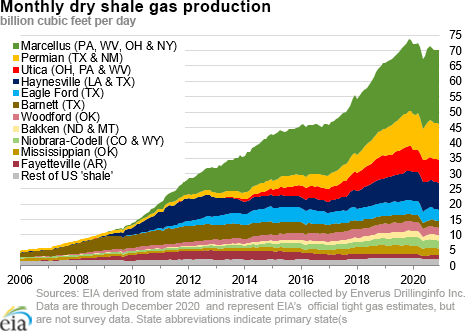In the News:
U.S. LNG exports exceed natural gas exports by pipeline
According to the U.S. Energy Information Administration’s (EIA) Natural Gas Monthly (NGM), in November 2020, monthly U.S. exports of liquefied natural gas (LNG) exceeded natural gas exports by pipeline by nearly 1.2 billion cubic feet per day (Bcf/d). Previously, this has happened only once since 1998, when in April 2020, LNG exports barely exceeded pipeline exports that month by 0.01 Bcf/d. Preliminary estimates for December 2020 and January 2021, based on the shipping data provided by Bloomberg Finance, L.P., suggest a continuation of this trend. In November and December 2020, U.S. LNG exports set two consecutive monthly records at 9.4 Bcf/d and 9.8 Bcf/d, respectively, and set another monthly record in January 2021 at 9.8 Bcf/d. In the January Short-Term Energy Outlook (STEO), EIA forecasts that U.S. LNG exports will exceed natural gas exports by pipeline in the first and fourth quarters of this year and on an annual basis in 2022, as global natural gas and LNG demand recover to pre-COVID-19 levels.
Since November 2020, all six U.S. LNG export facilities have been operating near full design capacity. In December, Corpus Christi LNG facility in Texas commissioned its third and final liquefaction unit (referred to in the industry as a train) six months ahead of schedule, bringing the total U.S. liquefaction capacity to 9.5 Bcf/d baseload (10.8 Bcf/d peak) across six export terminals that include 15 standard-size liquefaction units and 10 small modular liquefaction units. From November 2020 through January 2021, monthly U.S. LNG export volumes were almost three times higher than the monthly export volumes in the summer months of 2020. The recent significant increase in U.S. LNG exports has been driven by rising international natural gas and LNG prices, particularly in Asia, following a sustained period of significantly-below-normal temperatures in the key LNG-consuming countries in northeast Asia, as well as reduced global LNG supply caused by unplanned outages at several LNG export facilities worldwide. EIA forecasts that U.S. LNG exports will average 9.8 Bcf/d in February 2021, before declining to seasonal lows in the shoulder months, and will average 8.5 Bcf/d and 9.2 Bcf/d on an annual basis in 2021 and in 2022, respectively.
U.S. gross exports by pipeline to Mexico and Canada also grew in 2020, averaging 7.9 Bcf/d in the first 11 months of the year, 3% higher than during the same period in 2019, according to EIA’s NGM. Although pipeline exports to Canada declined by 5% in the first 11 months of 2020, U.S. pipeline exports to Mexico grew during the same period once the final segment of the pipeline system connecting the U.S. Permian Basin (Waha region) in West Texas with Mexico’s central-western Guadalajara region was brought online. Completion of the second phase of the Cempoala compressor station in the state of Veracruz in September 2020 has increased natural gas flows from southeast Texas via Sur de Texas‒Tuxpan underwater pipeline (2.6 Bcf/d capacity) into Mexico’s southern states on the Yucatan peninsula and in the central region. Completion of Mexico’s Samalayuca-Sásabe pipeline (0.47 Bcf/d capacity), which came online in January 2021, and the scheduled completion of the Tula‒Villa de Reyes pipeline (0.89 Bcf/d capacity) later this year are expected to further increase U.S. pipeline exports to Mexico.
Overview:
(For the week ending Wednesday, February 3, 2021)
- Natural gas spot prices rose at most locations this report week (Wednesday, January 27 to Wednesday, February 3). The Henry Hub spot price rose from $2.71 per million British thermal units (MMBtu) last Wednesday to $2.91/MMBtu yesterday.
- At the New York Mercantile Exchange (Nymex), the February 2021 contract expired last Wednesday at $2.760/MMBtu. The March 2021 contract price increased to $2.789/MMBtu, up 9¢/MMBtu from last Wednesday to yesterday. The price of the 12-month strip averaging March 2021 through February 2022 futures contracts climbed 4¢/MMBtu to $2.933/MMBtu.
- The net withdrawals from working gas totaled 192 billion cubic feet (Bcf) for the week ending January 29. Working natural gas stocks totaled 2,689 Bcf, which is 2% more than the year-ago level and 8% more than the five-year (2016–2021) average for this week.
- The natural gas plant liquids composite price at Mont Belvieu, Texas, rose by 38¢/MMBtu, averaging $7.51/MMBtu for the week ending February 3. The prices of natural gasoline, propane, butane, isobutane, and ethane all rose, by 3%, 3%, 5%, 8%, and 11%, respectively.
- According to Baker Hughes, for the week ending Tuesday, January 26, the natural gas rig count remained flat at 88. The number of oil-directed rigs rose by 6 to 295. The total rig count increased by 6, and it now stands at 384.
Prices/Supply/Demand:
Prices rise at most locations amid cold temperatures and snow on the East Coast. This report week (Wednesday, January 27 to Wednesday, February 3), the Henry Hub spot price rose 20¢ from $2.71/MMBtu last Wednesday to $2.91/MMBtu yesterday, after reaching a high of $3.18/MMBtu on Tuesday. Temperatures were generally warmer than normal across most of the Lower 48 states, but much colder than normal on the eastern seaboard. A large snowstorm moved across the Northeast and Mid-Atlantic regions Sunday through Tuesday, with snowfall exceeding 30-inches in some areas. At the Chicago Citygate, the price increased 23¢ from $2.62/MMBtu last Wednesday to $2.85/MMBtu yesterday.
Northeast prices rise substantially with heavy snowfall. At the Algonquin Citygate, which serves Boston-area consumers, the price went up $2.16 from $9.90/MMBtu last Wednesday to a high of $12.06/MMBtu yesterday. At the Transcontinental Pipeline Zone 6 trading point for New York City, the price decreased $2.00 from $5.17/MMBtu last Wednesday to $3.17/MMBtu yesterday after reaching a high of $5.46/MMBtu on Tuesday.
The Tennessee Zone 4 Marcellus spot price increased 22¢ from $2.43/MMBtu last Wednesday to $2.65/MMBtu yesterday. The price at Dominion South in southwest Pennsylvania rose 28¢ from $2.44/MMBtu last Wednesday to $2.72/MMBtu yesterday.
California prices fall. The price at SoCal Citygate in Southern California decreased 28¢ from a high of $3.46/MMBtu last Wednesday to $3.18/MMBtu yesterday amid warmer temperatures in the Los Angeles region compared to last week. The price at PG&E Citygate in Northern California fell 1¢, down from $3.56/MMBtu last Wednesday to $3.55/MMBtu yesterday.
Permian Basin prices trade within a relatively narrow range. The price at the Waha Hub in West Texas, which is located near Permian Basin production activities, averaged $2.60/MMBtu last Wednesday, 11¢/MMBtu lower than the Henry Hub price. Yesterday, the price at the Waha Hub averaged $2.77/MMBtu, 14¢/MMBtu lower than the Henry Hub price. On January 29, El Paso Natural Gas declared a force majeure that resulted in capacity reductions through the Cornudas compressor station located east of El Paso, Texas. According to S&P Platts, flows through Cornudas have declined by 267 million cubic feet per day (MMcf/d) since the force majeure was announced.
Supply falls, driven by decrease in production. According to data from IHS Markit, the average total supply of natural gas fell by 0.2% compared with the previous report week. Dry natural gas production decreased by 0.5% compared with the previous report week. Average net imports from Canada increased by 4.2% from last week.
Natural gas demand rises with increased demand for space heating. Total U.S. consumption of natural gas rose by 2.5% compared with the previous report week, according to data from IHS Markit. On January 28, total consumption reached nearly 124 Bcf/d, the highest level so far this winter. Natural gas consumed for power generation climbed by 3.1% week over week. In the residential and commercial sectors, consumption increased by 2.8%. Industrial sector consumption increased by 1.3% week over week. Natural gas exports to Mexico decreased 5.6%. Natural gas deliveries to U.S. liquefied natural gas (LNG) export facilities (LNG pipeline receipts) averaged 10.9 Bcf/d, or 0.88 Bcf/d higher than last week.
U.S. LNG exports increase week over week. Twenty-two LNG vessels (nine from Sabine Pass, four each from Cameron and Freeport, three from Corpus Christi, and two from Cove Point) with a combined LNG-carrying capacity of 80 Bcf departed the United States between January 28 and February 3, 2021, according to shipping data provided by Bloomberg Finance, L.P.
Storage:
The net withdrawals from storage totaled 192 Bcf for the week ending January 29, compared with the five-year (2016–2021) average net withdrawals of 146 Bcf and last year's net withdrawals of 155 Bcf during the same week. Working natural gas stocks totaled 2,689 Bcf, which is 198 Bcf more than the five-year average and 41 Bcf more than last year at this time.
According to The Desk survey of natural gas analysts, estimates of the weekly net change to working natural gas stocks ranged from net withdrawals of 182 Bcf to 216 Bcf, with a median estimate of 194 Bcf.
The average rate of withdrawals from storage is the same as the five-year average so far in the withdrawal season (November through March). If the rate of withdrawals from storage matched the five-year average of 11.2 Bcf/d for the remainder of the withdrawal season, the total inventory would be 2,004 Bcf on March 31, which is 198 Bcf higher than the five-year average of 1,806 Bcf for that time of year.
More storage data and analysis can be found on the Natural Gas Storage Dashboard and the Weekly Natural Gas Storage Report.
See also:
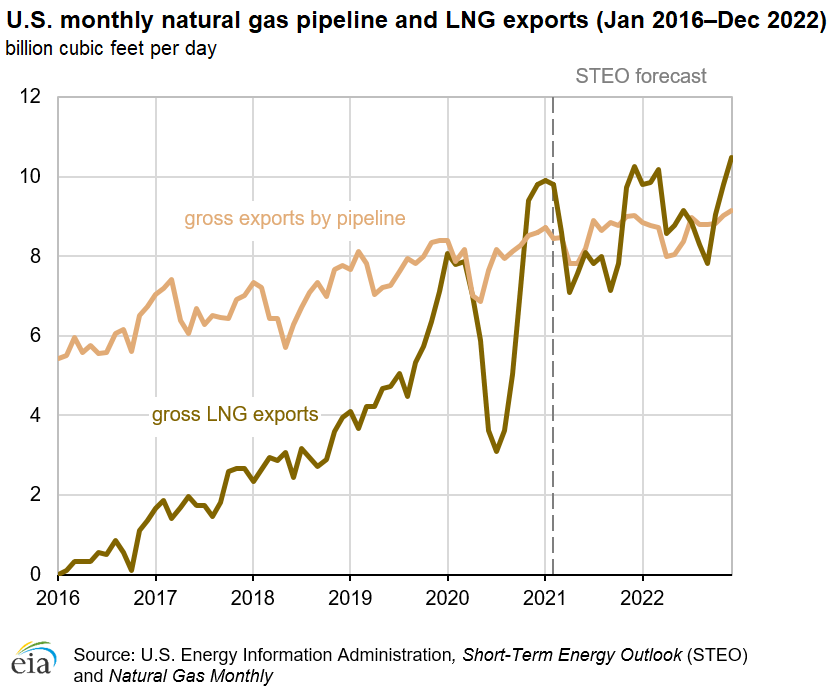
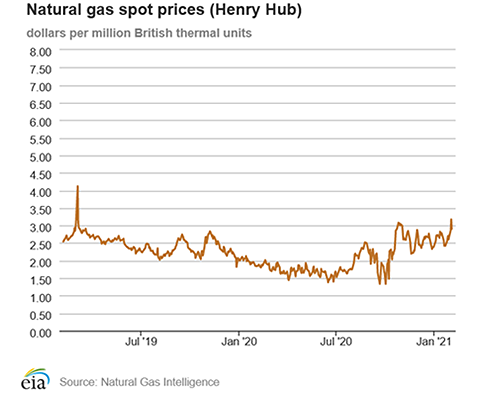
| Spot Prices ($/MMBtu) | Thu, 28-Jan |
Fri, 29-Jan |
Mon, 01-Feb |
Tue, 02-Feb |
Wed, 03-Feb |
|---|---|---|---|---|---|
| Henry Hub |
2.60 |
2.67 |
2.86 |
3.18 |
2.91 |
| New York |
6.00 |
3.05 |
5.29 |
5.46 |
3.17 |
| Chicago |
2.59 |
2.62 |
2.77 |
2.96 |
2.85 |
| Cal. Comp. Avg.* |
3.00 |
3.01 |
3.05 |
3.19 |
3.10 |
| Futures ($/MMBtu) | |||||
| March contract | 2.664 |
2.564 |
2.850 |
2.845 |
2.789 |
| April contract |
2.675 |
2.592 |
2.821 |
2.818 |
2.772 |
| *Avg. of NGI's reported prices for: Malin, PG&E Citygate, and Southern California Border Avg. | |||||
| Source: NGI's Daily Gas Price Index | |||||
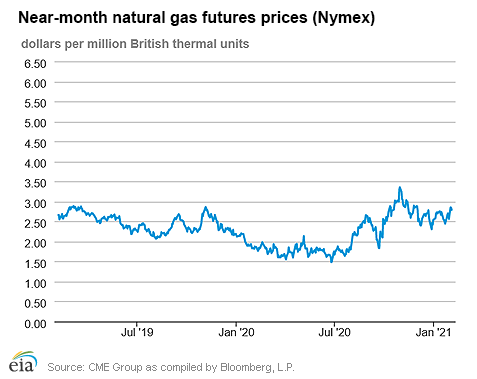
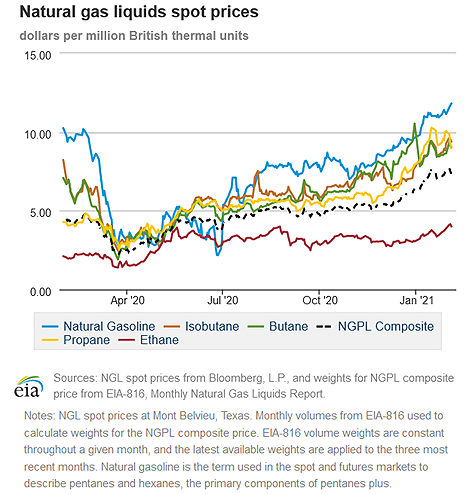
| U.S. natural gas supply - Gas Week: (1/28/21 - 2/3/21) | |||
|---|---|---|---|
Average daily values (Bcf/d): |
|||
this week |
last week |
last year |
|
| Marketed production | 102.3 |
102.8 |
105.4 |
| Dry production | 90.5 |
91.0 |
93.5 |
| Net Canada imports | 6.3 |
6.1 |
5.4 |
| LNG pipeline deliveries | 0.3 |
0.3 |
0.3 |
| Total supply | 97.2 |
97.4 |
99.2 |
|
Source: IHS Markit | |||
| U.S. natural gas consumption - Gas Week: (1/28/21 - 2/3/21) | |||
|---|---|---|---|
Average daily values (Bcf/d): |
|||
this week |
last week |
last year |
|
| U.S. consumption | 95.4 |
93.1 |
94.3 |
| Power | 27.6 |
26.8 |
30.4 |
| Industrial | 25.1 |
24.8 |
25.1 |
| Residential/commercial | 42.7 |
41.5 |
38.8 |
| Mexico exports | 5.5 |
5.9 |
5.3 |
| Pipeline fuel use/losses | 7.0 |
7.0 |
7.3 |
| LNG pipeline receipts | 10.9 |
10.0 |
9.4 |
| Total demand | 118.8 |
116.0 |
116.3 |
|
Source: IHS Markit | |||
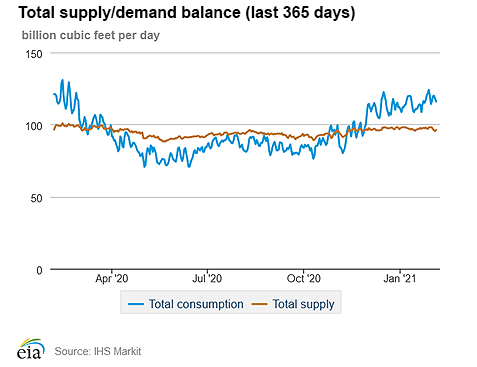
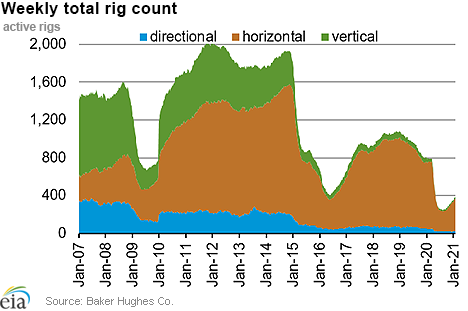
| Rigs | |||
|---|---|---|---|
January 29, 2021
|
Change from |
||
last week |
last year |
||
| Oil rigs | 295 |
2.1% |
-56.3% |
| Natural gas rigs | 88 |
0.0% |
-21.4% |
| Note: Excludes any miscellaneous rigs | |||
| Rig numbers by type | |||
|---|---|---|---|
January 29, 2021
|
Change from |
||
last week |
last year |
||
| Vertical | 22 |
22.2% |
-35.3% |
| Horizontal | 344 |
1.8% |
-51.6% |
| Directional | 18 |
-18.2% |
-60.0% |
| Source: Baker Hughes Co. | |||
| Working gas in underground storage | ||||
|---|---|---|---|---|
Stocks billion cubic feet (Bcf) |
||||
| Region | 2021-01-29 |
2021-01-22 |
change |
|
| East | 582 |
641 |
-59 |
|
| Midwest | 719 |
780 |
-61 |
|
| Mountain | 158 |
170 |
-12 |
|
| Pacific | 261 |
275 |
-14 |
|
| South Central | 970 |
1,014 |
-44 |
|
| Total | 2,689 |
2,881 |
-192 |
|
|
Source: Form EIA-912, Weekly Underground Natural Gas Storage Report | ||||
| Working gas in underground storage | |||||
|---|---|---|---|---|---|
Historical comparisons |
|||||
Year ago (1/29/20) |
5-year average (2016-2020) |
||||
| Region | Stocks (Bcf) |
% change |
Stocks (Bcf) |
% change |
|
| East | 609 |
-4.4 |
562 |
3.6 |
|
| Midwest | 735 |
-2.2 |
670 |
7.3 |
|
| Mountain | 138 |
14.5 |
140 |
12.9 |
|
| Pacific | 210 |
24.3 |
218 |
19.7 |
|
| South Central | 956 |
1.5 |
901 |
7.7 |
|
| Total | 2,648 |
1.5 |
2,491 |
7.9 |
|
| Source: Form EIA-912, Weekly Underground Natural Gas Storage Report | |||||
| Temperature – heating & cooling degree days (week ending Jan 28) | ||||||||
|---|---|---|---|---|---|---|---|---|
HDD deviation from: |
CDD deviation from: |
|||||||
| Region | HDD Current |
normal |
last year |
CDD Current |
normal |
last year |
||
| New England | 254 |
-21 |
34 |
0 |
0 |
0 |
||
| Middle Atlantic | 250 |
-13 |
36 |
0 |
0 |
0 |
||
| E N Central | 291 |
-4 |
57 |
0 |
0 |
0 |
||
| W N Central | 319 |
8 |
64 |
0 |
0 |
0 |
||
| South Atlantic | 151 |
-30 |
-13 |
10 |
2 |
7 |
||
| E S Central | 138 |
-47 |
-34 |
0 |
-1 |
0 |
||
| W S Central | 87 |
-48 |
-15 |
4 |
0 |
4 |
||
| Mountain | 237 |
10 |
55 |
0 |
-1 |
0 |
||
| Pacific | 157 |
41 |
63 |
0 |
-1 |
0 |
||
| United States | 217 |
-5 |
36 |
2 |
0 |
2 |
||
|
Note: HDD = heating degree day; CDD = cooling degree day Source: National Oceanic and Atmospheric Administration | ||||||||
Average temperature (°F)
7-day mean ending Jan 28, 2021
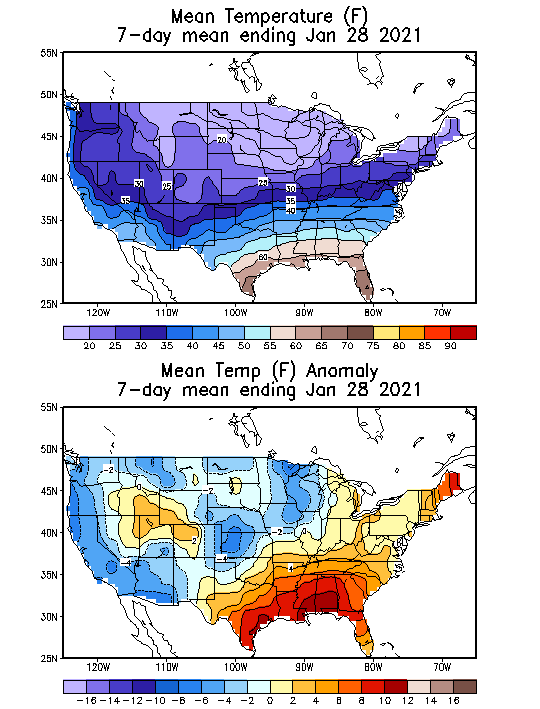
Source: National Oceanic and Atmospheric Administration
Deviation between average and normal (°F)
7-day mean ending Jan 28, 2021

Source: National Oceanic and Atmospheric Administration

